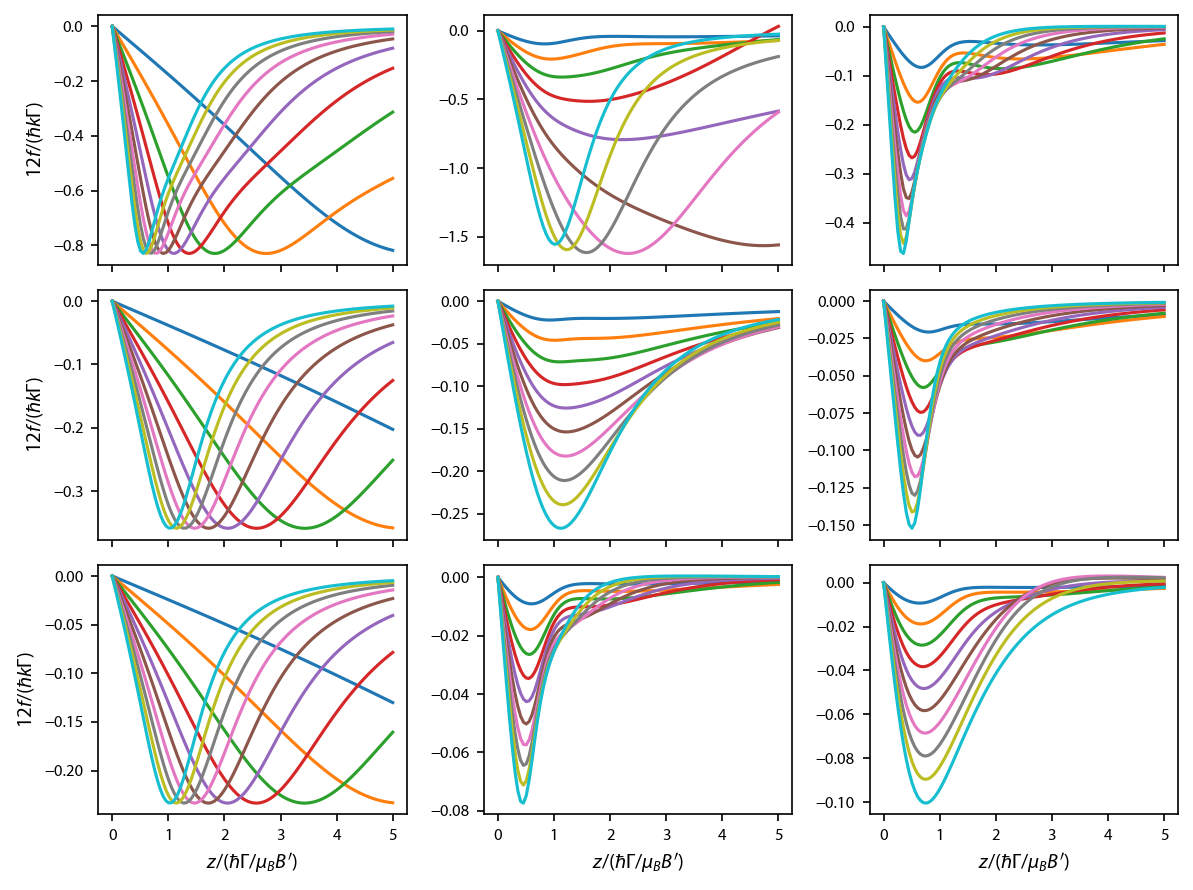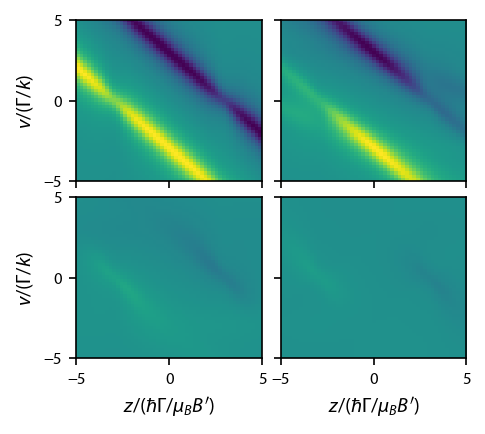General \(F \rightarrow F'\) 3D MOTs¶
This example covers calculating the forces in both type-I and type-II three-dimensional MOTs. In particular, we are trying to reproduce the results of M.R. Tarbutt, “Magneto-optical trapping forces for atoms and molecules with complex level structures” New Journal of Physics 17, 015007 (2015) http://dx.doi.org/10.1088/1367-2630/17/1/015007
We also take a look at what a subset of these MOTs look like as a function of both \(\mathbf{v}\) and \(\mathbf{r}\) as well.
[1]:
import numpy as np
import matplotlib.pyplot as plt
import pylcp
First, can we reproduce all the figures?¶
In the reference above, the forces for a variety of \(F\rightarrow F'\) MOTs are calculated for a variety of different upper state \(g_u\)-factors and three lower state \(g_l\)-factors.
Note that we turn of the magnetic forces for rateeq because we are using the same unit system as that in 01_F0_to_F1_1D_MOT_capture.ipynb. Here, we are not calculating any dynamics.
[2]:
det = -1.0
s = 1.0
# Make a z-axis
z = np.linspace(1e-10, 5, 100)
# Make the figure
fig, ax = plt.subplots(3, 3,figsize=(9, 6.5))
# Define the lasers:
laserBeams = pylcp.conventional3DMOTBeams(delta=det, s=s,
beam_type=pylcp.infinitePlaneWaveBeam)
# Define the magnetic field
magField = pylcp.quadrupoleMagneticField(1.)
Fs = [[1, 2], [1, 1], [2, 1]] # The Fs we want to run through
gl = np.array([0., 1., -1.]) # The lower state g factors to run
gu = np.arange(0.1, 1.1, 0.1) # The upper state g factors to run
for jj, (Fl, Fu) in enumerate(Fs):
for ii, gl_i in enumerate(gl):
for gu_i in gu:
# Case 1: F=1 -> F=2
Hg, Bgq = pylcp.hamiltonians.singleF(F=Fl, gF=gl_i, muB=1)
if Fu<Fl: # Reverse the upper state g-factor to get a confining force
He, Beq = pylcp.hamiltonians.singleF(F=Fu, gF=-gu_i, muB=1)
else:
He, Beq = pylcp.hamiltonians.singleF(F=Fu, gF=gu_i, muB=1)
dijq = pylcp.hamiltonians.dqij_two_bare_hyperfine(Fl, Fu)
hamiltonian = pylcp.hamiltonian(Hg, He, Bgq, Beq, dijq)
rateeq = pylcp.rateeq(laserBeams, magField, hamiltonian,
svd_eps=1e-10, include_mag_forces=False)
rateeq.generate_force_profile(
[np.zeros(z.shape), np.zeros(z.shape), z],
[np.zeros(z.shape), np.zeros(z.shape), np.zeros(z.shape)],
name='Fz')
Fz = rateeq.profile['Fz'].F[2]
ax[jj, ii].plot(z, 12*Fz)
if jj<2:
ax[jj, ii].xaxis.set_ticklabels([])
for ii in range(3):
ax[ii, 0].set_ylabel('$12f/(\hbar k \Gamma)$')
ax[2, ii].set_xlabel('$z/(\hbar \Gamma/\mu_B B\')$')
fig.subplots_adjust(wspace=0.25)

The rows correspond to (top to bottom) \(F=1\rightarrow F'=2\), \(F=1\rightarrow F'=1\), and \(F=2\rightarrow F'=1\), respectively. The columns correspond to \(g_l= 0., 1., -1.\), from left to right. Note that we use normalized units here, unlike in the reference, which uses lab units. They also use a Gaussian beam with a width defined in lab units, while we use infinite plane-wave beams. That accounts for the slight differences at large \(z\).
Now let’s look at the force in phase space:¶
We’ll constrict ourselves to \(g_l=0\) and \(g_u = 1/F'\).
[3]:
x = np.arange(-5, 5.1, 0.2)
v = np.arange(-5, 5.1, 0.2)
X, V = np.meshgrid(x, v)
det = -3.0
alpha = 1.0
s = 2.0
# Definte laser beams and magnetic field again:
laserBeams = pylcp.conventional3DMOTBeams(delta=det, s=s,
beam_type=pylcp.infinitePlaneWaveBeam)
magField = pylcp.quadrupoleMagneticField(alpha)
Fs = [[0, 1], [1, 2], [1, 1], [2, 1]] # The Fs we want to run through
plot_inds = [(0, 0), (0, 1), (1, 0), (1, 1)] # a map from Fs index to plot index
fig, ax = plt.subplots(2, 2, num="Comparison of F_z") # make the plot
for jj, (Fl, Fu) in enumerate(Fs):
# Generate the pieces of the hamiltonian:
Hg, Bgq = pylcp.hamiltonians.singleF(F=Fl, gF=0, muB=1)
if Fu<Fl: # Reverse the upper state g-factor to get a confining force
He, Beq = pylcp.hamiltonians.singleF(F=Fu, gF=-1/Fu, muB=1)
else:
He, Beq = pylcp.hamiltonians.singleF(F=Fu, gF=1/Fu, muB=1)
dijq = pylcp.hamiltonians.dqij_two_bare_hyperfine(Fl, Fu)
# Put all the pieces together into the full Hamiltonian:
hamiltonian = pylcp.hamiltonian(Hg, He, Bgq, Beq, dijq)
# Make the rateequations and generate the force profile:
rateeq = pylcp.rateeq(laserBeams, magField, hamiltonian,
svd_eps=1e-10, include_mag_forces=False)
rateeq.generate_force_profile(
[np.zeros(X.shape), np.zeros(X.shape), X],
[np.zeros(V.shape), np.zeros(V.shape), V],
name='Fz')
Fz0to1 = rateeq.profile['Fz'].F[2]
# Plot it up
ax[plot_inds[jj]].imshow(
Fz0to1,
extent=(np.amin(X[0, :]), np.amax(X[0, :]),
np.amin(V[:, 0]), np.amax(V[:, 0])),
origin='bottom',
aspect='auto',
vmin=-0.3,
vmax=0.3
)
# Put in axis labels, and turn off superfluous tick labels:
for ii in range(2):
ax[ii, 1].yaxis.set_ticklabels([])
ax[ii, 0].set_ylabel('$v/(\Gamma/k)$')
ax[0, ii].xaxis.set_ticklabels([])
ax[1, ii].set_xlabel('$z/(\hbar \Gamma/\mu_B B\')$')

